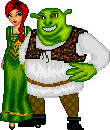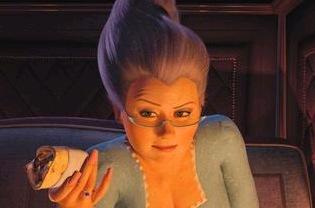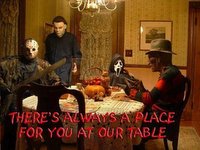Friday, September 29, 2006
· beauty (within narrow conventions)
· size/physique (again, within narrow conventions)
· sexuality (as expressed by the above)
· emotional (as opposed to intellectual) dealings
· relationships (as opposed to independence/freedom)
Women are often represented as being part of a context (family, friends, colleagues) and working/thinking as part of a team. In drama, they tend to take the role of helper (Propp) or object, passive rather than active. Often their passivity extends to victimhood (see the discussion of the misogynistic PantyRaider below). Men are still represented as TV drama characters up to 3 times more frequently than women, and tend to be the predominant focus of news stories.
The representations of women that do make it onto screen do tend to be stereotypical, in terms of conforming to societal expectations, and characters who do not fit into the mould tend to be seen as dangerous and deviant.
Discussions of women's representation in the media tend to revolve around the focus on physical beauty to the near-exclusion of other values, the lack of powerful female role models, and the extremely artificial nature of such portrayals, which bear little or no relation to the reality experience by women across the planet.
· Strength - physical and intellectual
· Power
· Sexual attractiveness (which may be based on the above)
· Physique
· Independence (of thought, action)
Male characters are often represented as isolated, as not needing to rely on others (the lone hero). If they capitulate to being part of a family, it is often part of the resolution of a narrative, rather than an integral factor in the initial equilibrium. It is interesting to note that the male physique is becoming more important a part of representations of masculinity. 'Serious' Hollywood actors in their forties (eg Willem Dafoe, Kevin Spacey) are expected to have a level of 'buffness' that was not aspired to even by young heart-throbs 40 years ago (check out Connery in Thunderball 1965).
Increasingly, men are finding it as difficult to live up to their media representations as women are to theirs. This is partly because of the increased media focus on masculinity - think of the burgeoning market in men's magazines, both lifestyle and health - and the increasing emphasis on even ordinary white collar male workers (who used to sport their beergut with pride) having the muscle definition of a professional swimmer. Anorexia in teenage males has increased alarmingly in recent years, and recent high school shootings have been the result of extreme bodyconsciousness among the same demographic group.
As media representations of masculinity become more specifically targeted at audiences with product promotion in mind (think of the huge profits now made from male fashion, male skin & haircare products, fitness products such as weights, clothing etc), men are encouraged (just as women have been for many years) to aspire to be like (to look/behave in the same way) the role models they see in magazines. This is often an unrealistic target to set, and awareness of this is growing.Whilst some men are concerned about living up to the ideal types represented in magazines, others are worried by what they perceive as an increasing anti-male bias in the media.
Wednesday, September 27, 2006
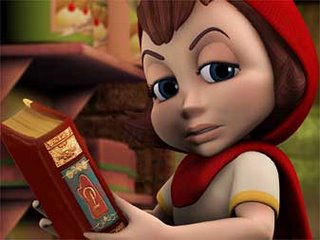
Hoodwinked is an ultra low budget affair compared to the average 3D CGI-animated film (it was shot for a reported 15 million vs 70 to 90 million for films like Finding Nemo or Shrek 2). If you want a fairer comparison in terms of animation quality, you'd have to look at something like Jimmy Neutron (30 million budget).
a review i found on: Hoodwinked
Friday, September 29 2006, 14:30 UTC - by Daniel Saney
Director: Cory EdwardsScreenwriter: Cory Edwards
Starring: Anne Hathaway, Glenn Close, James Belushi, Patrick Warburton
Running time: 81 mins Certificate: U
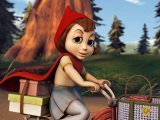
An interesting twist on the story of Red Riding Hood, Hoodwinked sees amphibious detective Nicky Flippers (David Ogden Stiers) questioning Red (Hathaway), the woodsman (Belushi), the wolf (Warburton), and Red's granny (Close), prompting flashbacks explaining how the four came together on the famous night. Which, if any of them, is responsible for a spree of Goodie recipe thefts? Presented in the style of a detective movie, Hoodwinked opens as Red Riding Hood is shocked to find a wolf in place of her grandmother and a manic woodsman crashing through the window. We then see the story coming from four different perspectives, and this is cleverly done, effectively keeping the interest of the adults whilst also being clear enough so as not to confuse children - even if the talk of APBs and such will fly over their heads.Despite a promising premise, however, there are a couple of hiccups in its execution. Firstly, and most obviously, is the quality of the animation, which looks a good few years behind the times. In a sense it's quirky and not completely without charm, but in the current climate of output from Pixar and DreamWorks Animation, Hoodwinked isn't the visual treat that audiences have come to expect. Since a fair proportion of the enjoyment gleaned from animated films is their aesthetic appeal, this is hardly a trivial grumble. The script isn't all it could have been but it does the job. While it does provoke a fair few chuckles, it's not the laugh-a-minute experience offered by the likes of the thematically-comparable Shrek. Some fun has been had with the characters' makeovers - the wolf is a sardonic reporter, Red's a martial arts champion and granny lives for extreme sports - although it's quite often the minor characters who are blessed with the better lines. One of the more memorable of them is the thankfully sparingly-used Twitchy, a hyperactive squirrel closely related to Over The Hedge's Hammy. Although not the most entertaining of its kind, and certainly not the best-looking, Hoodwinked is consistently interesting and original, and at a manageable 80 minutes it manages to remain enjoyable throughout and avoids stretching the material too far.
http://www.digitalspy.co.uk/article/ds37492.html
Monday, September 25, 2006
Propp -
Character Roles
1.The villain (struggles against the hero)
2.The helper (helps the hero in the quest)
3.The princess (person the hero marries, often sought for during the narrative)
4.Her father
5.The hero or victim/ seeker hero, reacts to the donor, weds the princess
Todorov –
Narrative
structure
- Starts of with and equilibrium – Shrek and Fiona on their honeymoon
- The dis-equilibrium begins when they receive and invation from
Fiona's parents - The resolution when Shrek and Fiona are accepted my the people in
“far far away”
Feminism
The historical texts I have chosen to look at are snow white and the seven dwarf,
Cinderella and sleeping beauty and in these texts the villains are all women
although they are playing a active role they are portrayed as evil. Moreover,
Cinderella, snow white and Bella all play the role of damsel in distress who
are waiting for a prince to come and save them which reinforces patriarchy.
Furthermore they take on a role to please men for example in snow white
The evil Queen is extremely beautiful and vain. She seduced and married
a widowed King.
binary oppostions in shrek 2
shrek vs fairygodmother
good vs evil
hero vs villian
male vs female
Economic context:
Shrek 2 is more expensive to produce as the characters in the film are 3D
compared to films like Cinderella where they characters are 2D.
Social context:
fairy godmothers who are usually women, who are typically represented as being motherly and caring. However, these days, women are
not like that as you get women abandoning their babies.
villians in my historical texts
The villain in this sleeping beauty is:
Maleficent -The wicked dark fairy
(Maleficent is a Latin-derived word
meaning harmful or
evil.)

Maleficent was often surrounded by eerie green flames implying that she had phenomenal powers of evil at her disposal
She dresses in black and her pet raven
Is black which reinforces to the audience
She is a villain as black connotes bad/evil.
the villian in cinderella is lady tremine
She also owned a very stubborn,
malicious cat named Lucifer, who
connotes her personality. Lady
Tremaine is represented as a bitter,
cruel, and selfish woman determined to
forward her own interests as well as that
of her daughters.
The villain of snow white and the seven dwarfs is The evil queen also known as
“Queen Grimhilde”
Friday, September 22, 2006
The 1950s – SHEP
Perhaps one of the things which most characterizes the 1950's was the strong element of conservatim and anticommunist feeling which ran throughout much of society. One of the best indicators of the conservative frame of mind was the addition of the phrase "under God" to the Pledge of Allegiance. Religion was seen as an indicator of anti-communism. Fifties clothing was conservative. Men wore gray flannel suits and women wore dresses with pinched in waists and high heels. French fashion designers such as Dior, Channel and Givenchy were popular and copied in America. Families worked together, played together and vacationed together at family themed entertainment areas like national parks and the new Disneyland. Gender roles were strongly held, girls played with Barbie dolls and Dale Evans gear, boys with Roy Rogers and Davy Crockett paraphernalia.Drive-in movies became popular for families and teens. Cars were seen as an indicator of prosperity and cool-ness. Highways were built to take people quickly from one place to another, by-passing small towns and helping to create central marketing areas or shopping malls such as Sharpstown Mall, Gulfgate Mall and Meyerland Plaza in Houston. Fashion successes were Bill Blass and his blue jeans, poodle skirts made of felt and decorated with sequins and poodle appliques, pony tails for girls, and flat tops and crew cuts for guys. Teenagers were defined as a separate generation and were represented by James Dean who wore blue jeans in Rebel Without a Cause and created a fashion and attitude sensation. Activities we liked were flying saucer watching , and watching and dancing to Dick Clark's American Bandstand . Fad hits with kids were toys like hula hoops and Hopalong Cassidy guns and western gear, Davy Crockett coon skin hats and silly putty .
Important Historic and Cultural Events
(1950195119521953195319531954195419551955195619581959)
- President
DATES
1950
India gives votes to women.
1951
The American photographer Eve Arnold is the first woman to work for the celebrated Magnum photographic agency.
1953
American aviator Jacqueline Cochrane (1910 - 1980) is the first woman to break the sound barrier.
1953
Equal pay is introduced for women teachers.
1953
Vijaya Lakshmi Pandit (1900- 1990) becomes the first woman president of the United Nations General Assembly.
1955
Barbara Mandell is the first woman to read the news on ITN.
1955
Rosa Parkes (born 1913) makes history on 1 December when she refuses to give up her seat to a white man on a bus, in Montgomery, Alabama. This sparks off the black civil rights movement in America.
1955
On 13 July convicted murderer Ruth Ellis is the last woman to be hanged in Britain.
1956
Egypt and Tunisia give votes to women.
http://www.katpad.co.uk/media%20website%202000/genre.html
http://www.filmeducation.org/primary/animation/index.html
http://www.aber.ac.uk/media/Sections/film.html
http://us.imdb.com/
http://www.rottentomatoes.com/
http://www.afi.com/
http://film.guardian.co.uk/patterson/story/0,,1779015,00.html
http://mediaknowall.com/gender.html
http://www.awn.com/mag/issue4.01/4.01pages/bevilacquaceleb.php3
Thursday, September 21, 2006
Wednesday, September 20, 2006

Adventure film: is one of the sub genres in Shrek 2. It is a film genre where the characters are placed in an exciting and often dangerous location far away from home. For example in Shrek 2 when Shrek goes to “far far away” to meet Fiona’s parents. Characters frequently face physical challenges for instance when Shrek has to break out of jail and rescue Fiona from Prince Charming. Adventure films are usually produced for family entertainment with a range of characters to appeal to all ages, genders and ethnicities.
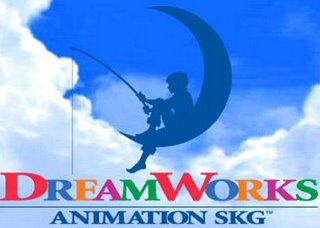
DreamWorks: digital animation film and television production and distribution company founded by Steven Spielberg, Jeffrey Katzenburg and David Geffen in 1994, a rival to Disney and producer of Shrek and Shrek 2 (Andrew Adamson, 2001 and 2004)

Femme fatale: a female character who uses her sexuality often in a devious, disreputable, secretive ways, to achieve the ends she desires. An example of this is in snow white and the seven dwarfs, the evil queen is extremely beautiful and vain and in the film she seduces the widowed king.
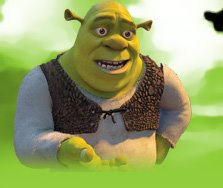
Hero: the principal male or female protagonist in any narrative, with whom the audience identifies and who exhibits moral virtues in line with dominant ideology. In shrek 2 Shrek is the hero.
Representation: the process whereby the media construct versions of people, places and events in images, words or sound for transmission through media texts to an audience.
Representations provide models of how we see gender, social groups, individuals and aspects of the world we all inhabit. They are ideological in that they are constructed within a framework of values and beliefs. Representations are therefore mediated and reflect the value system of their sources. No representation is ever real, only a version of the real.
Representations are part of cultural mythology and reflect deep-seated values and beliefs for example of such places the north of England, Scotland and America.Representation is the key to many media debates as is usually described as being positive or negative, depending on the view of the group being represented. Achieving positive representations has been a goal of minority groups who have criticised the perceived negativity of media stereotypes for example gays, ethnic minorities, religious minorities, disability and women.
Sunday, September 17, 2006
http://www.blogger.com/comment.g?blogID=31412118&postID=115831139759284131 HEENA
http://www.blogger.com/comment.g?blogID=34031519&postID=115841489243453075 NAVDEEP
http://www.blogger.com/comment.g?blogID=33429866&postID=115799930523285072 KAVITA
http://www.blogger.com/comment.g?blogID=32761268&postID=115711116571536374 SHERISH
Monday, September 11, 2006
The kingdom of Far, Far Away is Hollywood with stretch horse-drawn carriages instead of stretch limos, and the happy couple's arrival is covered like an Oscars red carpet telecast.which never offers anything dangerous or perceptive - just observation that it's glitzy, glamorous, and commercial.
The iconography of "sir justin" poster links to cameron diaz and justin timberlake's relationship in the real world and how Fiona's dream man would be justin timberlake simular to alot of teenage girls dream man.
Parallel sound is used when Shrek is going to find Fiona and he is riding on a white horse/ (donkey) and the diegetic sound is of the song lyrics saying “I need a hero” This is done to help the audience identify with Shrek.on the other hand as the fairy godmother is singing the song it makes it a bit ironic.
High key lighting
The name Shrek is taken from the Yiddish word שרעק (pronounced Shreck) meaning 'fear', 'terror', or (in its closest sense) 'fright', and the German "Schreck" with the same meaning
A sign similar to the Hollywood sign has the text "Far Far Away."
Also when they enter Far Far Away, Donkey's head with the palm tree background is a reference to Eddie Murphy's own Beverly Hills Cop.
While in bed, Fiona's mother reads a copy of "Kings Are from Mars, Queens Are from Venus", a play on Men Are from Mars, Women Are from Venus.
The Fairy Godmother visits a fast food restaurant named "Friar's Fat Boy", a reference to the US chain Frisch's Big Boy.
Puss in Boots inscribes the letter "P" into a tree using three strokes of his sword, parodying the character of Zorro where the callsign of the hero Zorro is slashing the letter "Z" using three sword strokes. Incidentally, Antonio Banderas, the actor voicing Puss in Boots, played Zorro in the 1998 film The Mask of Zorro.
In the scene where Shrek, Donkey and Puss in Boots arrive at the Fairy Godmother's office, she says "What in Grimm's name..."; a reference to the Brothers Grimm, who published collections of many fairy tales such as the ones used in this movie.
The arrival of guests on the red carpet at the royal ball show is being broadcast by "Medieval Entertainment" and is hosted by Joan Rivers, a reference to the E! Entertainment Channel, and to Joan herself, who usually interviews people arriving at the Oscars.
There is a visual spoof of Mission: Impossible when Pinocchio is lowered into the well.
Right after seeing the Fairy Godmother billboard, Shrek sits back in the chariot, and a "Burger Prince" logo can be seen on a building, a parody of Burger King, the fast-food emporium.
When the Fairy Godmother is ordering food at the Fast Food Restaurant she orders a Medieval Meal. This is a reference to McDonald's Happy Meal. The box of the Medieval Meal is also similar to the Happy Meal, although the paper crown that Charming wears refers to the Burger King crown.
In the scene where the group enters Far Far Away, there is a shot of hills and the Far Far Away sign. This scene is very much like the view of the Paramount Studios, except that there is actually the Hollywood Sign.
The love potion that the Fairy Godmother gives King Harold to give to Fiona is labeled "IX", a reference to the 1959 pop hit "Love Potion #9", by The Clovers.
There are numerous references to the King being a frog throughout the movie(as a parody of The Princess and the Frog. It could also be implied that they are the one and the same from the fairytale, except the frog is a bitter old king and they have a daughter and an ogre for a son-in-law):
He has a painting of his human self standing over a pond next to his bed.
His wife reminds him of their first date by the lake, their "first kiss"
His bedsheets and most of his furniture is leafy green.
A female frog in the bar asks him, "Don't I know you from somewhere?"
At the ball, the King and Queen are seated in front of a screen that has a painting of a pond with water lillies on it.
He turned into an actual frog by the Fairygodmother's spell.
Movie name Real name
Farbucks Coffee Starbucks Coffee
Burger Prince Burger King
Versarchery Versace
Saxon Fifth Avenue Saks Fifth Avenue
Old Knavery Old Navy
Tower of London Records London Records (or Tower Records)
Gap Queen The Gap
Banana Kingdom Banana Republic
Barneys Old York Barneys New York
Abercrombie & Witch Abercrombie & Fitch
Pewtery Barn Pottery Barn
Friar's Fat Boy Frisch's Big Boy
Baskin Robinhood Baskin Robbins
Armani Armoury Armani Exchange
Pork Illustrated Sports Illustrated
institutuion:
dreamworks- an American institution promotes American hegemony/American values, directed by: Andrew Adamson and Kelly Asbury, mainstream Hollywood film.
genre:
hybrid of animation, adventure, comedy, family, fantasy
The introduction featuring a reading from a storybook is a reverence to a similar introduction in Disney's Sleeping Beauty.
The scene during the dinner with Fiona's parents where the camera cuts to different characters and they say each other's names is a reference to a similar scene in Rocky Horror Picture Show.
At the start of the movie, when Shrek is caught in a trap and hanging upside down, he lands in some mud that covers his face. Fiona wipes off the mud to reveal his mouth and kisses him. This is a spoof of the Spider-Man movie, where Spider-Man is hanging upside down and Mary Jane Watson half-takes off his mask and kisses him in the rain. Also, in a later scene, Donkey warns Shrek not to drink the potion by saying my donkey-sense is tingling , a reference to Spider-Man's "spider-sense
References to wizard of oz:The Fairy Godmother arrives at Fiona's balcony encased in a bubble à la Glinda the Good Witch. And when Donkey's caught in the rain, he says "I'm melting! I'm melting!"; the same line that the Wicked Witch said when she met her demise.
The Fairy Godmother's first song is reminiscent of "A Spoonful of Sugar", one of the songs from the music Mary Poppins, which starred Julie Andrews, who provides the voice of Fiona's mother in this film.
There are a few references to Disney's Beauty and the Beast: The toadstool that is splattered by the "Happily Ever After" potion transforms into the rose from that film as well.Dancing furniture looks remarkably similar to those in Beauty and the Beast.
The first visit to the Poison Apple by the king shows several characters:
Cyclops
Captain Hook from Peter Pan
Dwarves fighting from Snow White.
Pirates
Haunted Ents
The Headless Horseman from The Legend of Sleepy Hollow
An ugly stepsister from Cinderella
Tinkerbell appears in the end of the movie dancing with Gingy.
When Shrek, Donkey and Puss in Boots escape from the potion storeroom in the Fairy Godmother's factory, Puss quickly reaches under the door to rescue his hat, as Indiana Jones does in Indiana Jones and the Temple of Doom.
At Shrek's house in the swamp, the Gingerbread Man — bored with watching the royal ball show — tells his fairy tale friends to flip over to "Wheel of Torture", which is a parody of Wheel of Fortune.
When the giant gingerbread man, Mongo, is "born", the little Gingerbread Man says "It's alive!": a reference to Frankenstein.
Puss in Boots sits in a chair and douses himself with water, just like Jennifer Beals did in Flashdance.
Pinocchio imitates Michael Jackson's famous "Billie Jean" dance routine on the dance floor during the ball scene.
When the potion that Shrek stole from the Fairy Godmother takes effect, a maiden gives him a pail of water and says her name is Jill, an obvious reference to the nursery rhyme, Jack and Jill.When Shrek, Donkey, and Puss are arrested, the knights put pepper in his face, a play on pepper spray.
representation:
In Shrek 2, The Fairy Godmother starred as the main antagonist and was voiced by British comedian Jennifer Saunders. Like most characters in the Shrek films the Godmother's original personality was changed. Instead of being kind and helpful, she was really a scheming, conviving, showbiz sort of a woman, who only wants to get the best for herself and her son, rather than others. She would often resort of blackmail and trickery through magic to get her way.
the king is represented as a bit manipulative and cowardly however the audience still like/identify with him as he is doing the wrong things for the right reasons.
the representation of Shrek is challanged, as ogres are usally seen as villians however he is portrayed as a hero which subverts sterotypes and encourages the audience to identify with him.
audience:
target at children/family movie appeals to all ethnicities and genders. Narrative pleasures provided are entertainment, identification with main protagonist
ideolgy/values:
the message underpinning the text is not to be predjuice and judge people by their appearance.
narrative:
ends with a closed narrative,
Propp’s theory on character roles,
Todorov’s theory on narrative structure
The King and Queen of Far Far Away went to fairygodmother to get help for their daughter princess Fiona; she was enchanted with a fearsome curse that made her a monster during the night but normal during the day; the Fairy Godmother advised that she be put in a tower guarded by a Dragon until Prince Charming would come and rescue her.
